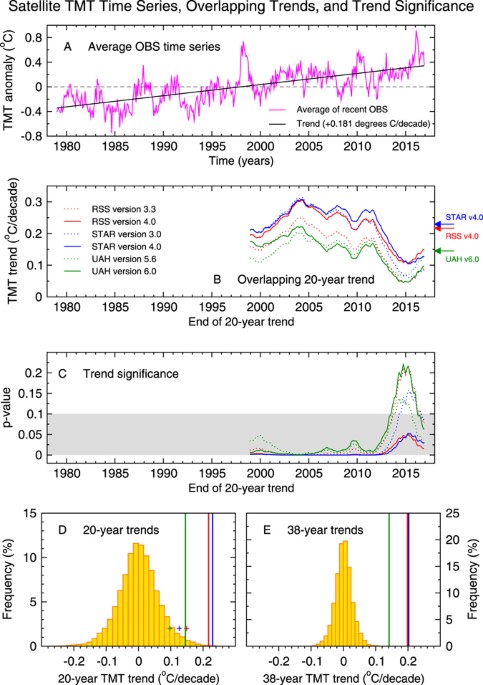- Joined
- Jan 28, 2013
- Messages
- 94,823
- Reaction score
- 28,342
- Location
- Williamsburg, Virginia
- Gender
- Male
- Political Leaning
- Independent
It's not exactly Star Wars but it's sort-of-a-big-deal anyway. RSS vs UAH: take your pick. I'm on the UAH team.
[h=2]Satellite battle: Five reasons UAH is different (better) to the RSS global temperature estimates[/h]
And so the adjustments war ramps up a notch.
There are two main groups that use essentially the same NASA and NOAA satellites to estimate global temperatures. In the last year, they’ve both made adjustments, one down, and one up, getting further apart in their estimates. In ClimateWorld this is a big deal. Believers are excited that now a satellite set agrees a bit better with the maligned “hot” surface thermometers. But UAH still agrees more with millions of weather balloons. The debate continues. Here’s my short synopsis of the Roy Spencer (and John Christy) from the “Comments on the new RSS lower tropospheric temperature set.” (If something is wrong here, blame me).
[h=4]The Bottom Line:[/h]1. Both data-sets show far less warming than what climate models estimate. UAH shows +0.12 C/decade, the new RSS trend is up to +0.17 C/decade. But climate models estimate +0.27 C/decade in the lower troposphere.
2. The headline suggesting that the RSS revisions found “140% faster warming since 1998” is the usual hype. The warming trend was tiny to start with. The headlines didn’t tell us that RSS is now warming a few hundreds of a degree per decade faster, because “who cares”?
[h=3]Five reasons UAH is different to RSS[/h]
Roy now predicts that the radiosondes will be adjusted to “agree” with the RSS version. This pattern of good data series being adjusted to agree with bad ones is a continuation of what happened to surface thermometers, where the worst sites are not removed from the series, but used to adjust the better sites.
All these points have finer details, which I’ll try to summarize below, but Roy Spencer’s blog is the place to read it all.
Keep reading →
[h=2]Satellite battle: Five reasons UAH is different (better) to the RSS global temperature estimates[/h]
And so the adjustments war ramps up a notch.
There are two main groups that use essentially the same NASA and NOAA satellites to estimate global temperatures. In the last year, they’ve both made adjustments, one down, and one up, getting further apart in their estimates. In ClimateWorld this is a big deal. Believers are excited that now a satellite set agrees a bit better with the maligned “hot” surface thermometers. But UAH still agrees more with millions of weather balloons. The debate continues. Here’s my short synopsis of the Roy Spencer (and John Christy) from the “Comments on the new RSS lower tropospheric temperature set.” (If something is wrong here, blame me).
[h=4]The Bottom Line:[/h]1. Both data-sets show far less warming than what climate models estimate. UAH shows +0.12 C/decade, the new RSS trend is up to +0.17 C/decade. But climate models estimate +0.27 C/decade in the lower troposphere.
2. The headline suggesting that the RSS revisions found “140% faster warming since 1998” is the usual hype. The warming trend was tiny to start with. The headlines didn’t tell us that RSS is now warming a few hundreds of a degree per decade faster, because “who cares”?
[h=3]Five reasons UAH is different to RSS[/h]
- UAH agrees with millions of calibrated weather balloons released around the world. RSS now agrees more with surface data from equipment placed near airports, concrete, airconditioners and which is itself wildly adjusted.
- In the latest adjustments UAH uses empirical comparisons from satellites that aren’t affected by diurnal drift to estimate the errors of those that are. RSS starts with model estimates instead.
- Two particular satellites disagree with each other (NOAA-14 and 15). The UAH team remove the one they think is incorrect. RSS keeps both inconsistent measurements.
- Diurnal drift probably created artificial warming in the RSS set prior to 2002, but created artificial cooling after that. The new version of RSS keeps the warming error before 2002, but fixes the error after then. The upshot is a warmer overall trend.
- UAH uses a more advanced method with three channels. RSS is still using the original method Roy Spencer and JohnChristy developed with only one channel (which is viewed from three angles).
Roy now predicts that the radiosondes will be adjusted to “agree” with the RSS version. This pattern of good data series being adjusted to agree with bad ones is a continuation of what happened to surface thermometers, where the worst sites are not removed from the series, but used to adjust the better sites.
All these points have finer details, which I’ll try to summarize below, but Roy Spencer’s blog is the place to read it all.
Keep reading →

